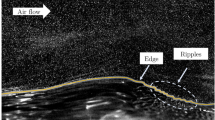Abstract
Ensemble average shapes of temperatureθ and vertical velocityw associated with a ‘ramp-like’ signature of the temperature signal recorded in the marine surface layer have been obtained with the use of a conditional sampling technique. The resulting shapes support the ‘ramp-like’ description of temperature and also suggest an approximately linear distribution in the case ofw. The sharp decrease in temperature at the upwind end of the ramp coincides with a relatively sharp decrease in vertical velocity. The region of the ramp in the vicinity of the sharp temperature decrease makes a large contribution to the average heat flux in the layer.
Similar content being viewed by others
References
Antonia, R. A.: 1972, ‘Conditionally Sampled Measurements Near the Outer Edge of a Turbulent Boundary Layer’,J. Fluid Mech. 56, 1–18.
Antonia, R. A., Chambers, A. J., Friehe, C. A., and Van Atta, C. W.: 1977, ‘Temperature Ramps in the Atmospheric Surface Layer’, Department of Mechanical Engineering, University of Newcastle, T.N. FM 16.
Antonia, R. A. and Van Atta, C. W.: 1978, ‘Structure Functions of Temperature Fluctuations in Turbulent Shear Flows’,J. Fluid Mech. 84, 561.
Davison, D. S.: 1974, ‘The Translation Velocity of Convective Plumes’,Quart. J. Roy. Meteorol. Soc. 100, 572–592.
Friehe, C. A. and Schmitt, K. F.: 1976, Parameterizations of Air-Sea Interface Fluxes of Sensible Heat and Moisture by the Bulk Aerodynamic Formulas’,J. Phys. Ocean,6, 801–809.
Haugen, D. A., Kaimal, J. C. and Bradley, E. F.: 1971, ‘An Experimental Study of Reynolds Stress and Heat Flux in the Atmospheric Surface Layer’,Quart. J. Roy. Meteorol. Soc. 97, 168–180.
Kaimal, J. C.: 1974, ‘Translation Speed of Convective Plumes in the Atmospheric Surface Layer’,Quart. J. Roy. Meteorol. Soc. 100, 46–52.
Kaimal, J. C. and Businger, J. A.: 1970, ‘Case Study of a Convective Plume and a Dust Devil’,J. Appl. Meteorol. 9, 612–620.
Kovasznay, L. S. G., Kibens, V., and Blackwelder, R. F.: 1970, ‘Large-scale Motion in the Intermittent Region of a Turbulent Boundary Layer’,J. Fluid Mech. 41, 285–320.
Schmitt, K. F., Friehe, C. A. and Gibson, C. H.: 1976, ‘Humidity Sensitivity of Atmospheric Temperature Sensors by Salt Contamination’,J. Phys. Ocean. 8, 151–161.
Sreenivasan, K. R., Britz, D. and Antonia, R. A.: 1978, ‘Structure of Turbulent “Bulges” in an Axisymmetric Jet’, Lecture Notes in Physics76 (Springer-Verlag, ed. H. Fiedler),Proceedings of Symposium on Turbulence, Berlin, 1977, 19–30.
Taylor, R. J.: 1958, ‘Thermal Structures in the Lowest Layers of the Atmosphere’,Aust. J. Phys. 11, 168–176.
Author information
Authors and Affiliations
Rights and permissions
About this article
Cite this article
Antonia, R.A., Chambers, A.J. Note on the temperature ramp structure in the marine surface layer. Boundary-Layer Meteorol 15, 347–355 (1978). https://doi.org/10.1007/BF02652606
Received:
Published:
Issue Date:
DOI: https://doi.org/10.1007/BF02652606




